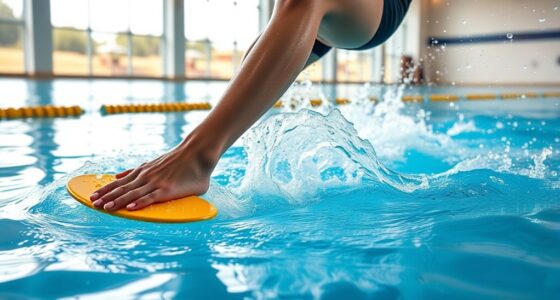You can build upper body strength without weights by using bodyweight exercises like push-ups, incline push-ups, and pull-up variations to target your shoulders and back. Resistance bands are great for mimicking swimming motions and improving stability, while exercises like rows and shoulder presses with bands or alternative equipment can boost muscle power. Incorporating these workouts into your routine will help enhance your water performance; keep exploring for more effective strategies.
Key Takeaways
- Use resistance bands for exercises like pull-aparts and rows to target upper body muscles without weights.
- Perform bodyweight movements such as push-ups, pike push-ups, and inverted rows to build strength.
- Incorporate suspension training or TRX exercises for increased stability and shoulder engagement.
- Focus on controlled, swimming-like motions to enhance muscle activation and functional strength.
- Structure workouts with circuit-style sets, performing each move for 30-60 seconds, at least three times weekly.

Building upper body strength is essential for swimmers looking to improve their performance in the water. You don’t always need weights to develop powerful shoulders, back, and arm muscles. Instead, you can use bodyweight exercises and simple tools like resistance bands to get your muscles firing. Dumbbell exercises are great, but if you don’t have access to weights, resistance band workouts are an excellent alternative. They offer adjustable resistance, making it easy to target specific muscles and gradually increase the challenge as you get stronger.
Start with basic resistance band exercises such as band pull-aparts, which focus on your rear deltoids and upper back. To perform this move, hold the band with both hands, arms extended in front of you, and pull the band apart until your arms are fully extended to the sides. Squeeze your shoulder blades together and control the release. This exercise mimics the pull phase of swimming strokes and helps improve shoulder stability and posture. It’s simple, effective, and easy to incorporate into your routine.
Perform band pull-aparts to strengthen rear delts and upper back, improving posture and swimming stability.
You can also do resistance band rows, which target your lats, rhomboids, and biceps. Attach the band to a sturdy anchor at waist height, hold the handles, and pull towards your torso while squeezing your back muscles. Keep your elbows close to your sides and avoid using momentum. Controlled movements are key to building strength. These workouts enhance your pulling power and help prevent shoulder injuries, which are common among swimmers.
In addition to resistance band workouts, dumbbell exercises can be adapted for your home or gym. For example, if you have access to light dumbbells, focus on exercises like shoulder presses and bent-over rows. If not, bodyweight alternatives like pike push-ups and inverted rows can be just as effective. Pike push-ups mimic overhead pressing, strengthening your shoulders, while inverted rows work your upper back and arms without weights. You can also add variations like single-arm push-ups or plank shoulder taps to intensify your workout and target stabilizing muscles.
To maximize your upper body strength, combine resistance band workouts with bodyweight exercises. Use a circuit approach—perform each movement for 30-60 seconds, rest briefly, then move to the next. This keeps your muscles engaged and increases endurance. Consistency is key; aim for at least three sessions a week, gradually increasing resistance and repetitions. Remember, building strength isn’t just about lifting heavy; it’s about controlled, deliberate movements that mimic swimming motions. Additionally, incorporating suspension training can further enhance your upper body strength by engaging stabilizer muscles more effectively. With dedication and the right exercises, you’ll notice improved power, stability, and endurance in the water.
Frequently Asked Questions
Can Bodyweight Exercises Alone Build Enough Upper Body Strength for Competitive Swimming?
Yes, bodyweight exercises can build enough upper body strength for competitive swimming. They enhance muscle endurance and help you maintain power through longer sets. Plus, focusing on exercises like push-ups and planks improves your technique by increasing control and stability in the water. Consistent training with these exercises develops the strength needed, allowing you to perform better in competitions without relying on weights.
How Often Should Swimmers Perform Upper Body Strength Routines Without Weights?
You should perform upper body strength routines without weights 2 to 3 times a week, allowing for proper recovery. This training frequency helps you build muscle while reducing injury risk and preventing overtraining. Focus on exercises like push-ups, planks, and dips to strengthen your shoulders, back, and arms. Consistent workouts improve your swimming efficiency, but listen to your body to avoid strain and guarantee steady progress.
Are There Specific Stretches to Enhance Upper Body Flexibility for Swimmers?
Think of your shoulders as a well-oiled hinge—they need to move smoothly. Incorporate dynamic stretching like arm circles and shoulder rolls to boost shoulder mobility. These stretches warm up muscles, improve flexibility, and prevent injuries. For instance, I noticed my shoulder discomfort decreased after consistently practicing shoulder mobility drills. Regularly doing these stretches enhances your upper body flexibility, making your swim strokes more efficient and comfortable.
What Are the Signs of Overtraining Upper Body Muscles Without Weights?
You might notice signs of overtraining your upper body muscles when you feel persistent muscle fatigue and joint pain. If your muscles remain sore or weak long after workouts, that’s a clear warning sign. Joint pain, especially around shoulders and elbows, can also indicate overuse. Pay attention to these symptoms, and give your muscles adequate rest to avoid injury and promote proper recovery.
How Can Swimmers Track Progress in Upper Body Strength Without Gym Equipment?
Tracking your upper body strength progress is like watching a plant grow—it takes patience. You can do this without gym equipment by using dumbbell alternatives like water bottles or resistance bands. Resistance band benefits include adjustable resistance and versatility. Keep a workout journal, noting reps and how challenging each exercise feels. Over time, you’ll notice improvements in endurance and control, showing your strength is steadily increasing.
Conclusion
Building upper body strength without weights unlocks your true swimming potential. Remember, your body is your most powerful tool—like a ship’s sail that catches the wind. With dedication and consistent effort, you’ll harness your strength and glide through water with ease. Embrace the journey, knowing each push-up or plank is a stroke toward mastery. Ultimately, your strength isn’t just about muscles, but about unleashing the swimmer within—ready to conquer every wave that comes your way.









